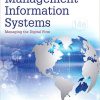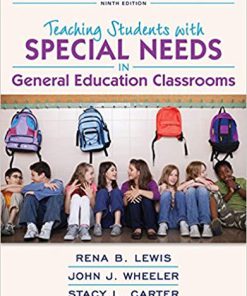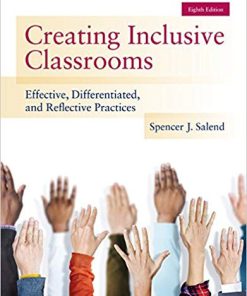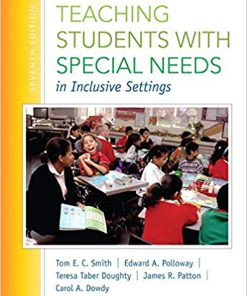(eBook PDF) Teaching in Today’s Inclusive Classrooms 3rd Edition
$50.00 Original price was: $50.00.$35.00Current price is: $35.00.
(eBook PDF) Teaching in Today’s Inclusive Classrooms 3rd Edition – Instant Download
(eBook PDF) Teaching in Today’s Inclusive Classrooms 3rd Edition – Digital Ebook – Instant Delivery Download
Product details:
- ISBN-10 : 1305500997
- ISBN-13 : 978-1305500990
- Author: Richard M. Gargiulo, Debbie Metcalf
TEACHING IN TODAY’S INCLUSIVE CLASSROOMS: A UNIVERSAL DESIGN FOR LEARNING APPROACH, 3rd Edition is a concise, accessible, and current text for the Introduction to Inclusive Teaching course. It is the only inclusion textbook available with a consistent, integrated emphasis on Universal Design for Learning (UDL)an important, contemporary educational philosophy focused on using strategies and tools to help ALL students by accommodating their differences. Aligned with InTASC and CEC standards, this text also provides foundational information about children with disabilities who are included in today’s classrooms, and the most effective strategies for teaching them alongside their typically developing peers. Featuring new material on Common Core State Standards, case studies, and sound research-based teaching and learning strategies, this hands-on text offers you a practical, flexible framework for effective instruction, classroom management, assessment, and collaboration in today’s diverse classrooms.
Table of contents:
Part I: FOUNDATIONS FOR EDUCATING ALL LEARNERS.
1. Teaching in Today’s Inclusive Classrooms: Your Journey Begins.
2. Introducing Universal Design for Learning.
3. Policies, Practices, and Processes for Special Education and Inclusive Education.
4. Diversity in the Classroom: Learners with High-Incidence Disabilities.
5. Diversity in the Classroom: Learners with Low-Incidence Disabilities.
6. Learners with Gifts and Talents, Learners Who Are Culturally and Linguistically Diverse, and Other Learners at Risk.
Part II: PLANNING INSTRUCTION FOR ALL LEARNERS.
7. Collaboration and Cooperative Teaching: Tools for Teaching All Learners.
8. Designing Learning That Works for All Students.
9. Assessing and Evaluating Learner Progress.
10. Selecting Instructional Strategies for Teaching All Learners.
11. Selecting Behavioral Supports for All Learners.
Part III: IMPLEMENTING EFFECTIVE INSTRUCTIONAL PRACTICES FOR ALL LEARNERS.
12. Assistive Technologies and Innovative Learning Tools.
13. Creating Literacy-Rich Environments for All Learners.
14. Developing an Understanding of Mathematics in All Learners.
15. Teaching Critical Content in Science and Social Studies to All Learners.
People also search:
inclusive classroom examples
what are the roles of teacher in inclusive education
in today’s classrooms diversity is seen as
what is inclusive teaching and learning
why inclusive classrooms are important
You may also like…
Education Studies & Teaching
Ebook-PDF
(eBook PDF) Teaching Students with Special Needs in General Education Classrooms 9th Edition











